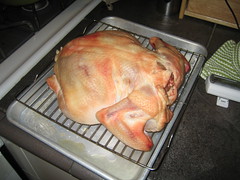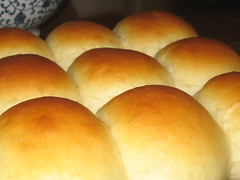Melanie challenged us to roast a chicken, so I did. I followed the recipe she posted, and I have to admit that I was a little skeptical of the dry salt rub. I guess I never fully understood why brining works in the first place. From what I remember of high school chemistry, when you have a high concentration salt solution (the brine) and a low concentration salt solution (any liquid already in the chicken), the liquid would flow from low to high to equalize the concentrations, the exact opposite of what we want! Yet brined chickens and turkeys are definitely more juicy... what gives?
Thankfully, this post on brining at cooking for engineers explains it all:
Obviously, there's more going on than simple osmosis. It is true that salt enters the meat (it tastes more salty after brining). But why is it also more juicy? Well, when water flows out of the meat, salt flows in and begins to break down some of the proteins in the cells. In the broken down state, the molecules become more concentrated and the solute levels rise within the meat. This causes additional water to flow into the meat.
Well said sir. Thus, a dry salt brine will theoretically do the same work as a regular brine. But will it really? Here's what it will do: turn your chicken pink!
I had originally planned to cook my chicken on Friday night after a few hours in the fridge. However, Amy and I were both tired and not very hungry, so we decided to delay until Saturday night. However, we were out late bouncing around post-caucus parties, so I didn't end up cooking it until Sunday night. The recipe states a max of two days in the fridge, so I was still ok for time... but during all that time in the fridge, my chicken started to turn pink. I don't know if it was the salt or just the time in the open air, but it was definitely an interesting look.
Color aside, time to roast. I stuff my chicken with a sliced up Meyer lemon and maybe eight cloves of garlic, chopped up in big chunks. I didn't have any twine, so I twisted up some tin foil into sort of a homemade twist-tie and used that to tie the legs. Olive oil and pepper on the outside (I skipped the sugar suggested by the recipe). Roast! Except I did it backwards. You are supposed to start it breast-side down for the first 30 minutes, but I totally did it backwards. Oh well. Not exactly a disaster.
Here begins the hardest part of roasting a chicken... is it done? I hit the requested temperature on my thermometer and let the chicken rest for 30 minutes, but even so, I still feel like I had some pink spots near the thigh joint. I know there is a major wow factor in presenting a whole roasted chicken or turkey at the table, but I usually end up carving the entire thing up into component parts almost immediately. I think in the future I'm going to lean towards carving up the bird before roasting. Takes less time to cook and more consistent cooking. We'll see.
I whipped up a quick marsala gravy (same recipe as the pinot noir gravy from thanksgiving, but with marsala wine instead). Tasted ok, but didn't rock my world. Once everything was prepped, it was off to the HCI potluck and my bird's date with destiny. I had promised Kayur, the organizer, that I was "bringing meat." Mission accomplished. I also made rolls:
Oh baby.




4 comments:
Those rolls look good! What recipe did you use? I've tried two very different recipes recently and neither was quite what I was looking for.
I was in Japan, which own an art beside a bakery, ice cream and cake, such as those who write a blog.
Arbitrary, but in the future I hope it will help link.
If it's okay, my blog also links please.
ICE CREAM JAZZ~SWEETS in Japan~
I love chicken very much. I will try this at my home and i hope it works the way you achieved it.
Thanks for sharing this blog. I use to cook chicken with red dry wine. It is yummy.
Free Brazilian Recipes
Post a Comment